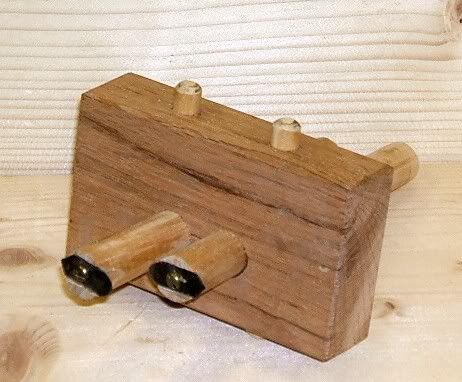Ooooh, that's a very nice design. The cost is a little high, though. I wonder how hard it would be to make something like that.
I do something similar to this with the cheap 2-arm mortise gauge that you can get from Lee Valley. I chop a test mortise first (in whatever wood), stick the blades in the hole, then tighten up with the blades on the mortise walls. The Kinshiro would be really nice for that.
The difficult part about making it is the blades - which are smithed specifically for this application. I'm sure a good blacksmith could make them, but I don't know of any way to source a pair. A resourceful woodworker might be able to heat and bend some O1 stock for the purpose, but it's not the simplest design to replicate.
The woodworking portions are done to a very precise level of course, but there's really nothing particularly difficult in there. This actually seems like a pretty interesting project to take a stab at...
What about these? I assume something about them is not as good as a $200+ model, but much more affordable:
$35
http://www.japanwoodworker.com/produ...&dept_id=12996
$33
http://www.japanwoodworker.com/produ...&dept_id=12996
Veni Vidi Vendi Vente! I came, I saw, I bought a large coffee!
Hi Brian
They look pretty good to me. I looked at these myself some time back, then was given my gauge as a gift (!).
Regards from Perth
Derek
As it happens, I bought a set of Kinshiro's blades for the smaller gauge to make my own because Kinshiro had already announced he was quitting and gauges were few and far between in the US; but before I could get it made, Tomohito Iida came up with a large Kinshiro gauge. I still expect to make the small gauge for small work.
Pam
Thanks to all that have responded. As usual, the collective wisdom and experience here is what makes the 'Creek such a great place to visit. I especially appreciate the tips on how you each use your gauges to mark mortises. Mahalo!
Brian,
I believe those are Kokaji made - which is the brand that was recommended to me for a lower cost alternative by So Yamashita (japan-tool.com) down under. His assessments have always been dead-on for me in the past.
Last edited by Raney Nelson; 08-06-2009 at 11:27 AM.
Hi Raney
If So says they are good, then they are good. Incidentally, he lives not in Japan but in Sydney (actually the northern beaches, close to Narrabeen, an old windsurfing haunt of mine a few decades ago, before we moved to Perth).
Regards from Perth
Derek
Like Bob, I use my mortise gauge for marking out my tenons. When the mortise and tenon board are flush (not always), sure, I'll go ahead and mark the tenon.
I think the best gauge is a fixed pin gauge. Just a stick with two carefully filed nails fitted with a moveable fence. A serviceable gauge can be made without a moveable fence as well.
The pins should have a flat side, which is what I think Derek was showing.
Adam
A mortice gauge is a whole lot more convenient than a marking gauge when marking out mortices. This because the width you have set remains constant from one mark out to the next, whereas if you used a single blade /pin marking gauge this width could vary according to any variation in timber thickness, assuming that you mark from each side as normal-but at least the mortice will be on centre. This may not be the case with a double pin-unless you check by marking from both sides- but at least the width stays the same
Traditional mortice gauges have pins, but these should be filed so that there is a mini knife profile, in which case they work nicely just like ones with knives or wheels.
My mortice gauge came from London, is stamped "J. Buck-maker- London 1870" and is made of African Blackwood. I replaced the pins with sewing machine needles which are mighty hard and strong. My marking gauge is self made.
A piece of Oak, 2 5/8" dowels, 2 3/8" dowels, 2 pieces of old hand saw blade, 2 small brass screws, a 5/8" bit and a 3/8" bit, and 45 minutes and a quick marking gauge is born. Not pretty, but functional.

Last edited by harry strasil; 08-07-2009 at 4:54 PM.
Jr.
Hand tools are very modern- they are all cordless
NORMAL is just a setting on the washing machine.
Be who you are and say what you feel... because those that matter... don't mind...and those that mind...don't matter!
By Hammer and Hand All Arts Do Stand